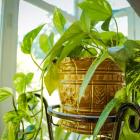Why the heck do my houseplants keep dying?!


With the coronavirus pandemic mandating working remotely, it afforded me the opportunity to head home to work while also seeing my family. When I returned home, I saw that the variety of plants we have around the house could have used a little extra TLC when I was gone. My dad asked me if he was doing everything right and I took some time to try and teach him some good tips to keep the plants healthy and happy. Here I will share some of those tips with you!
When it comes to houseplants, one of the most important aspects of their care is how much to water the soil. Generally speaking, watering plants may only require you to supply them a small amount of water every other day. Ultimately, however, the question always arises “How do I know when is enough or too little?” One of the best tricks I’ve learned is to first take some soil from the top of the pot or just below the surface in your hand. Then, place the soil between your thumb and index finger and squeeze it. If water squeezes out from the soil then it is likely still fine on water, if not, it could probably use some watering. One major consideration when conducting this test is how large the pot is you are testing. Both width and depth are critical in weighing the validity of this test. If you water from the top of the plant, this can alter the results of the test as only the top of the soil profile may truly possess the level of water you just tested. The best way to water, therefore, is to fill a lipped plate underneath the pot with water and let the water wick up through the soil profile to the plant. This will ensure the soil at the top you are testing is an accurate indicator of the rest of the pot, generally speaking.
The next most key consideration is certainly the lighting. It typically goes without saying but be certain to place your plant near a well-lit window. In an apartment setting finding the space to do this can certainly sometimes be easier said than done. I have found in my experience that placing your plant near a strong lamp light can work surprisingly well in keeping the plants alive even over long periods of low light. Even providing your plant with around 4 to 5 hours of artificial bulb light a day has in the past worked in keeping my plants healthy during dark periods like the winter or a particularly gloomy week. Any lightbulb will work fine, however growth bulbs are out on the market and provide plants with the wavelengths of light they need the most to grow.
The final biggest consideration is your soil health. Many houseplants get potted once and stay in their pot until they eventually die or severely outgrow the pot. Providing plants in any setting with the correct amount of soil is vital to their health. Plants by nature tend to take up about twice as much area below ground with their root structure as they do above it. With this in mind, I’m sure your thinking ‘man, I need a huge pot then?’ and the best answer is yes, yes you do! Seeing as placing these huge pots around your house is as unlikely for you as for me, the rule of thumb is to at least get as large a pot as possible and certainly bigger than the pot your plant originally was purchased in. It is key to repot your plant as it grows not only because the plant desires space to expand its root zone but also because over time your soil will become ‘worn out’ from use. Fertilizing can help bring back new life to heavily used soil by replenishing it with key nutrients but over time salts will accumulate in the soil forming white dust or crust on your soil from the natural salts found in your drinking water. After a decade of use (like some soil at home in pots) this is not an uncommon sight. This salt build-up stunts plant growth and in some cases can immobilize nutrients the plant needs to survive. The salts can be flushed out of the soil by taking the whole plant (still in the pot) outside and flushing them out through the bottom with a watering hose but simply repotting will take about the same amount of time with a far greater upside.
I hope these tips help you keep your houseplants happy and healthy for months and years to come! And, if one of your plants does keel over, don’t worry, it happens to me too, and I’m a plant scientist.
Written by TPS Fellow Cullen Dixon
